Very often happens that important things or beginnings of artistic movements, changes, and dialogues start just outside our doorstep! So this time around we would like to present very intriguing Polish emerging artists.
Quadratum Nigrum is an art group established in 2010, formed by Mateusz Okoński, Jakub Skoczek and Jakub Woynarowski. QN dig conspiracy theories and cracks in history. Employing classical works of the avant-garde and drawing inspirations from remote times, they combine them into new and often startling compositions.
In the recent exhibition ‘Fiat Lux’, as before in ‘Quadratum Nigrum’ (2010), ‘Mundus Subterraneus’ (2012) and ‘Civitas Munita’ (2013), authors trace avant-garde preoccupations back to the modern art period. The artists’ introduction to the myth of ‘Hermetic modernism’ reveals an alternative genealogy of twentieth-century art, particularly of its non-objective themes. The group’s original suprematist ritual emerges only through sounds, words, and structures of elementary geometric shapes and biblical numbers of symbolic sense. We enter a disturbing, cryptic and stimulating domain of abstract sensation.

Quadratum Nigrum: Mateusz Okoński, Jakub Skoczek and Jakub Woynarowski, ‘Fiat Lux’ 2015 Krakow, photo Studio FilmLove courtesy the artists and Bunkier Sztuki
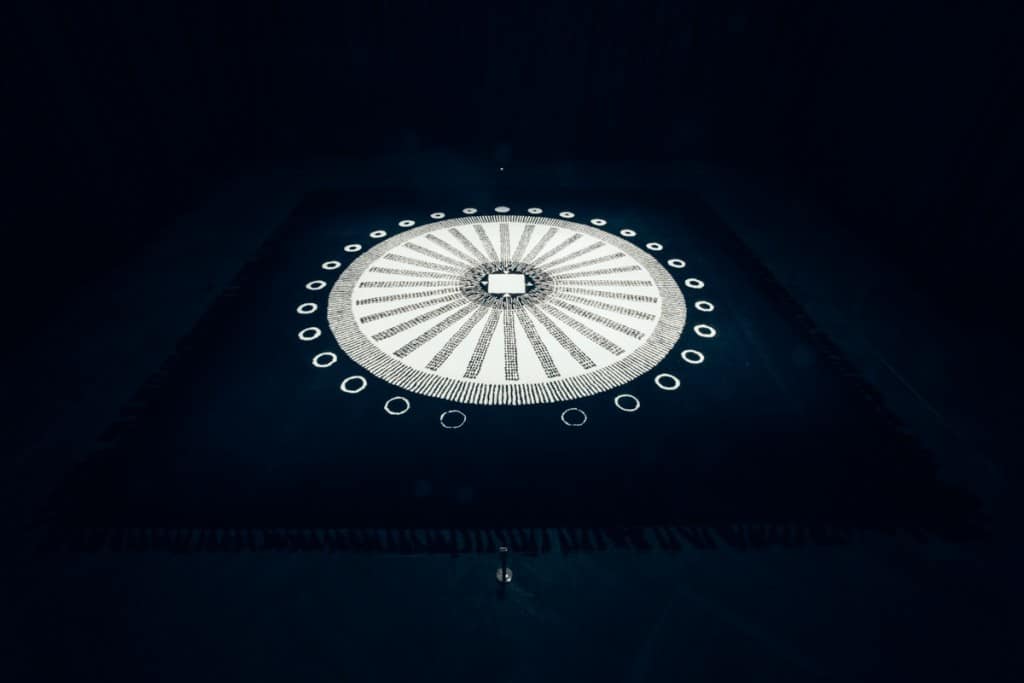
Quadratum Nigrum: Mateusz Okoński, Jakub Skoczek and Jakub Woynarowski, ‘Fiat Lux’ 2015 Krakow, photo Studio FilmLove courtesy the artists and Bunkier Sztuki
Marta Lisok: The title of your recent exhibition comes from the scriptural phrase ‘Let there be light’, yet the dominant feature of your project ‘Fiat Lux’ is, quite perversely, darkness…
Jakub Woynarowski: Both light and darkness blind the viewer. That kind of experience is extreme in nature, keeps balancing on the boundaries of strong sensation and intellectual hint of infinity. In this context, it is worth referring to the very first exhibition we put together as a group. Arranging ‘Quadratum Nigrum’, a project dating back to 2010, involved filling the gallery with the smoke of burning incense, used in religious ceremonies. That created thick fog indoors, which glared and dazzled. The sensuous veil concealed an intellectual tale, constructed of archaic exhibits. The darkness found in ‘Fiat Lux’ is not a void either: it is filled with invisible yet dense spatial and sonic structure. I think that such tension between sensory and mental experiences defines the field of our exploration very well: we situate ourselves between the ideas of white cube and darkroom.
Marta Lisok: How would you relate ‘Fiat Lux’ to earlier realisations of Quadratum Nigrum?
Mateusz Okoński: One aspect recurring in our activity is sacralisation of art space. The gallery in a way resembles a sanctuary, where artworks are relics and artists’ actions become religious rites.
Jakub Woynarowski: Sanctuaries — Hans Belting compared those to artistic installations — leave room for the divine to manifest itself. A similar phenomenon can be observed in Wunderkammers — collections of curiosities built with the aim of creating a perfect metaphor for a ‘microcosm of the world’. Despite exhaustive project, the cabinet’s composition — as a set of exceptions proving the rule — must always remain open. The essence of both these kinds of space lies in experience of exceptionality transformed into a sensation of the world’s ‘weirdness’. Following that intuition, we conceived our first exhibition as an amalgam of sanctuary and Wunderkammer. Extravagance delivers us from exaltation. The sublime is salvaged by singularity.
Jakub Skoczek: Another aspect common to all our projects is the empirical, sensuous one. It may be linked with corporeality of artefacts, and with less perceptible qualities too. Our first exhibition already provided a good example of that.
Jakub Woynarowski: Our second project, entitled ‘Mundus Subterraneus’, which translates as “The Underground World”, paradoxically existed on the top storey of the building. Having broken through a nineteenth-century attic, the viewer walked straight into a blindingly bright room with a glass ceiling, most likely suffering a thermal and visual shock at the time of doing so. Single black marks standing out against the brilliant white setting constituted the structure of a minimalist message. Also ‘Civitas Munita’, realised the following year in the urban space of Krakow’s district Podgórze, referred directly to a certain tangible concept: flags hung on the streets of the former Austrian town harked back to the old heraldry of guilds. Craft is a matter of our particular interest, for it involves immediate formation of substance as well as guarding exclusive knowledge and skill…
Mateusz Okoński: The members of Quadratum Nigrum act in that context as keepers of secret art. Each of our projects envisages ‘voids’, and deciphering them is a condition of initiation. Incomplete understanding nurtures a desire to unravel the mystery.
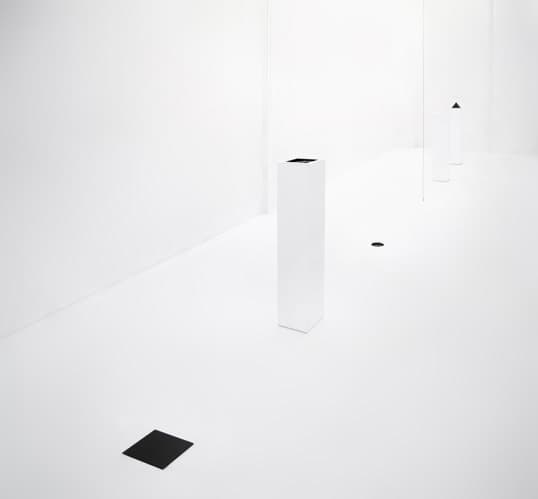
Quadratum Nigrum: Mateusz Okoński, Jakub Skoczek and Jakub Woynarowski, ‘Mundus Subterraneus’ 2012 Krakow, photo courtesy the artists
Marta Lisok: What is the narrative structure of the ‘Fiat Lux’? The motif of journey, for instance, is fairly evident…
Jakub Skoczek: Here, we invoke the dynamics of pilgrimage, or even that of the Way of the Cross. Behind the institution’s door, one passes information about the exhibition, given in Latin, a note of caution, and then a marble plate, reminding the visitor of a gravestone, inscribed with the exhibition’s ‘birth’ and ‘death’ dates in gilt Antiqua type. There follows another barrier: metal bars, drawn back only once an hour. Beyond, a black cuboid emerges as a pavilion, ajar and as such encouraging to come in and see the enclosed exhibit, which is a spotlit rug covered with a geometrical design.
Jakub Woynarowski: That Hermetic picture precedes a wall of darkness.
Jakub Skoczek: Indeed the second chamber is profoundly dark, and the musical composition — a fourteen-minute ‘suprematist mass’ — sounds there. The entrance to that room is at once the exit. Consequently the route of the visit invites the viewer to return to the first chamber on his or her way out. The exhibition’s structure is governed by symmetry. The journey through its space resolves into circles, loops, motions without a beginning or an end.
Jakub Woynarowski: An analogy can be drawn between the element of discomfort we have envisaged and the way labyrinths found on the floors of medieval cathedrals worked. The pilgrimage embarked on by kneeling congregations within structures designed by architects represents the tension I discussed. The labyrinth combines the designer’s mathematical precision with physical and emotional experiences underwent by the ‘user’.
Mateusz Okoński: Like medieval cathedrals, our exhibition is oriented. Spatial structures of the two rooms are based on occurrence of mirror image. Both the pavilion and the sound installation are arranged in a square and along the east–west axis. The pavilion’s architecture, as well as the shifting sound source, makes the viewer follow the shape of a circle. The rug itself expresses the idea of squaring the circle. The black square makes background for a circular solar diagram…
Jakub Woynarowski: …resembling a dilating eye’s pupil, a lens focusing rays of light…
Jakub Skoczek: …or a monstrance! The centre of that image may be blank or solid depending on the point of view.
Mateusz Okoński: And another square appears in the middle of the composition, formed by the four cardinal directions and the four classical elements.
Marta Lisok: ‘Fiat Lux’ derives from a rather intriguing confrontation of two squares, each of significance for art history…
Jakub Woynarowski: We perceive art as a whole, and therefore we avoid artificial distinctions, division into styles and eras; we explore it from a rather anthropological than historical perspective. We have an interest in affinity, in circulation of motifs.
Mateusz Okoński: We are not art historians, and we don’t employ conventional methodologies proper to that domain. We compose our own, alternative narration while attempting to investigate archaic roots of modernity. We call that approach ‘Hermetic modernism’.

Quadratum Nigrum: Mateusz Okoński, Jakub Skoczek and Jakub Woynarowski, ‘Mundus Subterraneus’ 2012, photo courtesy the artists
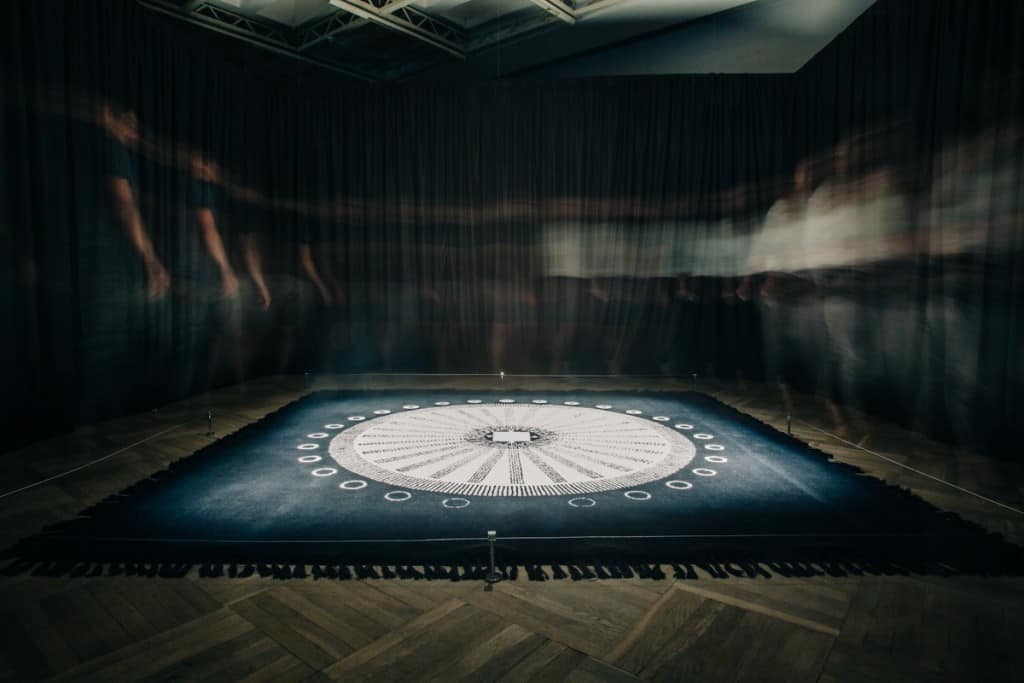
Quadratum Nigrum: Mateusz Okoński, Jakub Skoczek and Jakub Woynarowski, ‘Fiat Lux’ 2015 Krakow, photo Studio FilmLove courtesy the artists and Bunkier Sztuki
Jakub Skoczek: We were inspired above all by the relation of Kasimir Malevich’s ‘Black Square on a White Ground’ to the black square produced by Robert Fludd in 1617. What caught our attention in the latter, a picture illustrating the thinker’s book, namely the chapter thereof devoted to the world creation process, was a text element, not present in Malevich’s work. On each side of that square there’s the phrase ‘et sic in infinitum’, meaning ‘and so on to infinity’ in Latin, which suggests that we’re dealing with a fragment of a larger whole: a module, a piece of some net, a window…
Mateusz Okoński: In Malevich’s canvas, considering that it refers to icon painting, the black square in fact becomes a ‘window’. Fludd treats it as a fraction of the infinite, or as a speculum for examining it, pasted into a book.
Jakub Skoczek: It seems that what the two creators visualised was materia prima, a conglomerate of all beings, accumulated in a single scene. Black is desolation, chaos, nothingness, but it is also the sum of all potentials. The entire area of Fludd’s square is densely hatched. The course of strokes, clearly visible, is a record of the physical aspect of creation. Black is here far from perfect, reveals the texture of ink and paper. That shape is not so much a square, but simply a quadrilateral. Tension between a mathematically precise idea and the way of expressing it reflects the dissonance between geometry and organic matter. In this context, it is worth having a closer look at the cracked surface of Malevich’s painting, which obviously acquired antiquarian status. After a century, we find the avant-garde in the field of vintage.
Mateusz Okoński: The structure of Fludd’s picture resembles woven threads forming a cloth. Our rug is a projection of that image. The phrase ‘and so on to infinity’ finds its equivalent in fringes, seventy-seven of them on each side of the rug. 77 is a biblical number designating infinity. Another religious analogy can be found in the word ‘tabernacle’, meaning ‘a tent’: in Judeo-Christian culture the tent used to function as a place where one could symbolically meet God.
Jakub Woynarowski: The structure we have meticulously planned leaves room for the irrational to come into existence, precisely the ‘blank’ space in the middle of the rug. The four sides thereof, assigned to the four classical elements, frame a zone representing the fifth element, an intangible one, not so much ‘existing’, but continually ‘occurring’. Its function is the same as that of the middle point of the musical composition, when all sounds cease and leave room for the tuning fork and the note A, used as a reference for the musical temperament prevalent in our cultural region as well as for the work in question: it is the constituents of that sound — the so-called harmonics — that provided the basis for the entire piece, which takes the form of a ‘musical ziggurat’.
Marta Lisok: Could you explain the structure behind the musical layer of your installation?
Jakub Woynarowski: Successively introduced sonic elements are layered until the form reaches a climax, followed by inversion of vertical motion and descent down to the fundamental coordinate of musical structure. That is a moment of introspection, entrance into the subconscious. At the time of collapse the instruments reveal their physicality: the organ lacks air, and the descending sound of pipes resembles human respiration.
Jakub Skoczek: To me, the metaphor of breathing seems generally useful. Plunging into darkness makes one catch his or her breath. That silence, however, is not complete: in the pivotal moment, apart from the tuning fork, declamation of the phrase ‘et sic in infinitum’ is heard. After these words the form returns ‘upwards’, and the musical structure raised before recurs, rendered in retrograde.
Jakub Woynarowski: The entire composition is structured using organ and human voice — two instruments that employ moving air. In spite of the possibility of synthesising sound, we wanted to use natural, analogue timbres. There was reason for ultimately recording the piece using the LP format, on black discs packed in jackets with a chalcographic reproduction of Fludd’s illustration.
Jakub Skoczek: The low-frequency tone produced by the lower organ stops, rather than being audible, is perceptible directly: the listener’s body acts as an instrument that conducts vibration of the air.
Jakub Woynarowski: The organ’s low A is gradually enriched with its successive constituents, the harmonics, fourteen of them in total. Complexity of the vocal layer is inversely proportional to that of the organ part: the number of constituents is being reduced until only one remains. The entire piece is composed of twenty-eight segments. This figure is not accidental, of course: it is the product of numbers 4 and 7, both of which are crucial for our project. Also the lunar cycle lasts for this many days, which is reflected in symbolic design covering the rug. A circular diagram, inspired by Fludd’s image of separating light from darkness, is surrounded with twenty-eight white circles, at first gradually absorbed by black spots growing inside them, afterwards returning to their original condition. Our primary inspiration was the natural, month-long cycle related to lunar phases, where new moon and full moon take turns. Our exhibition’s duration of one month is not a coincidence either.
Jakub Skoczek: Another number important to us is three. ‘Fiat Lux’ involves three authors, three singers, as well as three languages in which chants based on the words of Kasimir Malevich and Robert Fludd are performed: Latin, German and Russian. Fludd used Latin in his writings, while the original text of ‘The Non-Objective World’ treatise saw the light of day in Russia, and before long was published in Germany. Malevich, writing about formal considerations in leaving the figurative field in favour of abstract territories, employed expressions proper to religious texts. His vision assumed that the advent of suprematism would see physics superseded by metaphysics.
Jakub Woynarowski: Another inspiration behind our project — besides Fludd and Malevich — is the diagram ‘De circulo physico, quadrato…’ by Michael Meier, where the four elements have been assigned four epithets that describe the condition of matter: ‘damp’, ‘hot’, ‘dry’ and ‘frigid’. These words constitute the text of declamation accompanied by sounds of an altar gong, a gavel, a chisel-struck stone and an altar bell respectively. The rug, inspired by both Fludd’s work and Meier’s diagram, is in fact the score of the musical piece, and a particular case of graphic notation as such.
Mateusz Okoński: All those elements make up the concept of a hypothetical rite, perceptible mostly through sensuous feelings. Black and darkness symbolically invite to enter the abyss, reset one’s perception, and experience non-linear time. The viewer’s body has to adapt to new circumstances, to dynamics of the unusual tour, meant to sharpen his or her senses. In this context, the exhibition is an invitation to contemplation.
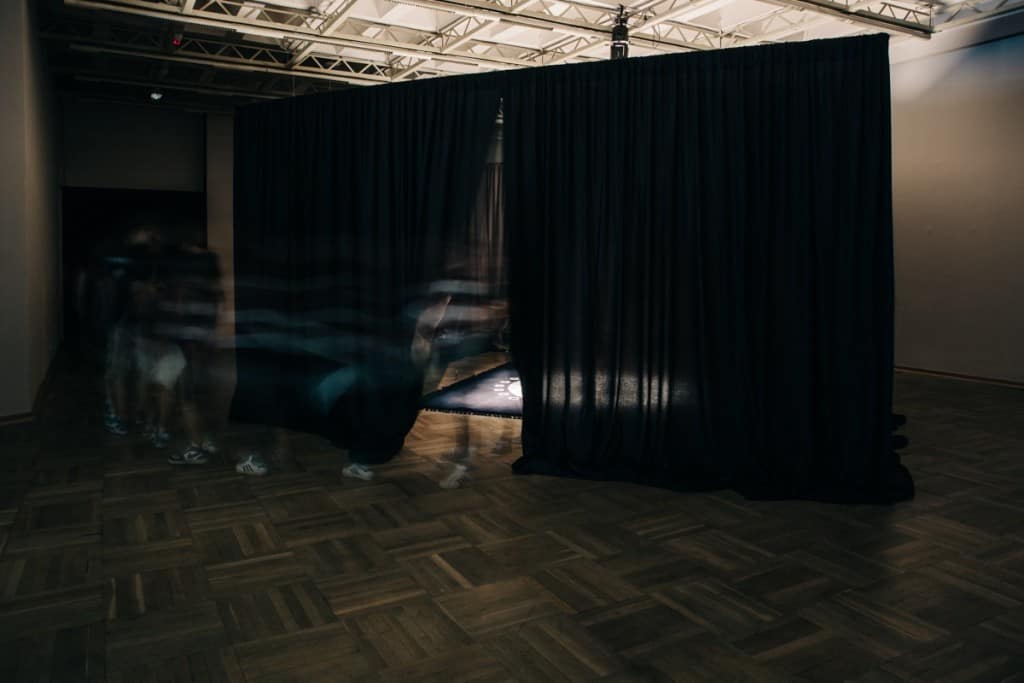
Quadratum Nigrum: Mateusz Okoński, Jakub Skoczek and Jakub Woynarowski, ‘Fiat Lux’ 2015 Krakow, photo Studio FilmLove courtesy the artists and Bunkier Sztuki

Quadratum Nigrum: Mateusz Okoński, Jakub Skoczek and Jakub Woynarowski, ‘Fiat Lux’, 2015 Krakow, photo Studio FilmLove courtesy the artists and Bunkier Sztuki
Marta Lisok: The exhibition seems to elude the viewer’s insight by blurring all clues and tangling interpretative paths. Visitors face one obstacle after another: Latin, Hermetic symbols, bars, drapes, finally a wall of darkness…
Jakub Skoczek: Our exhibition held in Bunkier Sztuki reflects the dynamics proper to liturgy. The presence of bars, drapes and other sorts of barriers contradicts the often postulated situation of complete openness and accessibility of art. Now that we’re talking, I dawn on the atmosphere one may associate with Tridentine Mass, celebrated in Latin by a priest facing not the congregation but the altar.
Jakub Woynarowski: The viewers have to wait before the bars, like the congregation prior to entering the ceremonial space. I think that the keyword allowing to understand our intention is ‘inhibition’. Complicated structures and constructs of successive barriers impede quick, non-reflective reception of the situation that we have arranged. Our aim is to disturb the viewer’s routine.
Jakub Skoczek: An interesting reference may be that to the process of ‘writing’ an icon, an activity conceptual in nature, even mathematical, because of strict rules governing the use of elements made by the painter. At the same time, considering the context in which icons function, the creator becomes the viewer: it is the image that’s looking at the beholder.
Mateusz Okoński: Visual arts have a lot in common with poetry. Forcing interpretations of art and determined attempts at facilitating reception of works are, to me, like translating with the well-known Google’s tool. Similarity between art and poetry is especially apparent in ancient iconology, which is a sophisticated, highly complicated language, now unfortunately forsaken. We wish that kind of know-how would regain continuity as a result of our activity. We’re trying to align it with the present-day reality.
Jakub Woynarowski: Analysing the elaborate iconographic programmes of old works is enough to refute the common claim of exceptional inaccessibility of contemporary art, which is, at bottom, a non-verbal language. Ease of reception does not guarantee quality at all. There have been not a few aesthetic concepts that included planned discomfort caused to the viewer, such as Girolamo Cardano’s idea of subtlety or Edmund Burke’s understanding of the sublime.
Jakub Skoczek: Calculated inconvenience can provide specific pleasure, as was the case for the medieval labyrinths we talked about.
Mateusz Okoński: That is a kind of satisfaction connected with acts of passage.
Jakub Woynarowski: We are dealing here, as a matter of fact, with a leap into depths and back to the surface, which can be seen both in the structure of musical composition and in the way the entire tour has been planned. I think that one could interpret our exhibition as hinting at the story of entombment and resurrection.
Jakub Skoczek: In view of that, it is worth making mention of the Nativity icon where the event has been located — in spite of the Nativity scene tradition — in a dark cave under the ground, filled with profound blackness. The time of birth symbolically foreshadows Christ’s descent into the abyss that preceded the Resurrection. That situation is interesting above all for two reasons. One is that we encounter a rite of passage. The other is the concept of non-linear time: a single icon gives account of the entire life of Jesus.
Mateusz Okoński: A black square becomes a symbol of initiation, and association is drawn between entrance into a non-objective world and death or danger.
Jakub Skoczek: The background of initiation that you’re talking about is a compelling thought indeed. Let us remind what baptism involved in the first centuries of Christianity: the person receiving the sacrament had to submerge completely. Immersion in water was equivalent to death, whereas emersion meant rebirth, and this is precisely the purpose of darkness in our installation. What happens to the viewer here is not only inhibition, but also immersion in another reality — death and return to life.
Translated from Polish by Błażej Bauer.
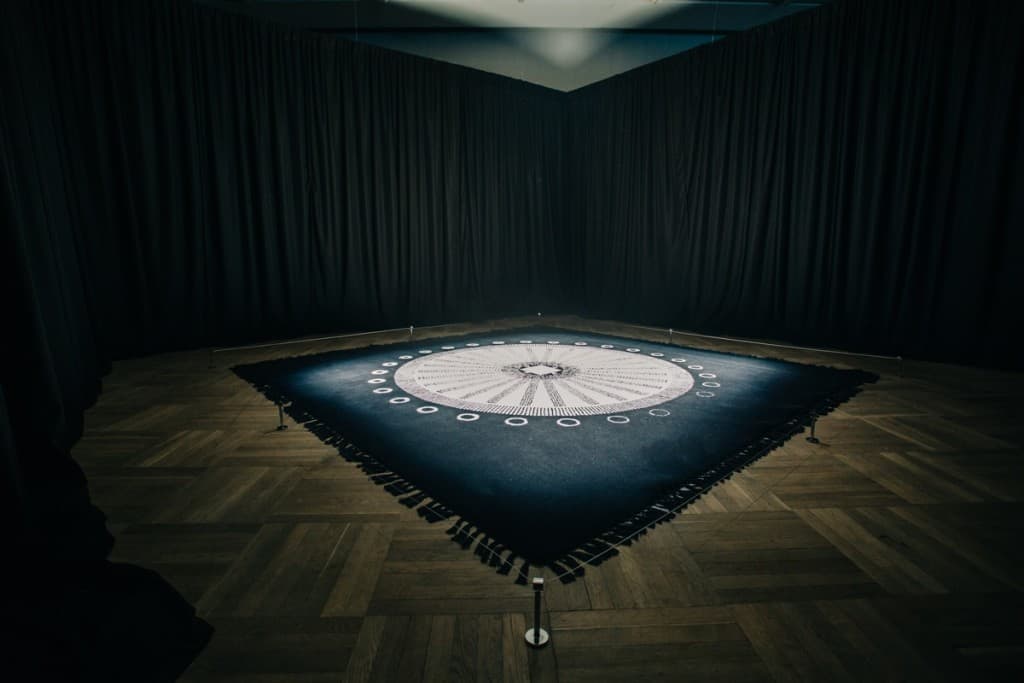
Quadratum Nigrum: Mateusz Okoński, Jakub Skoczek and Jakub Woynarowski, ‘Fiat Lux’, 2015 Krakow, photo Studio FilmLove courtesy the artists and Bunkier Sztuki
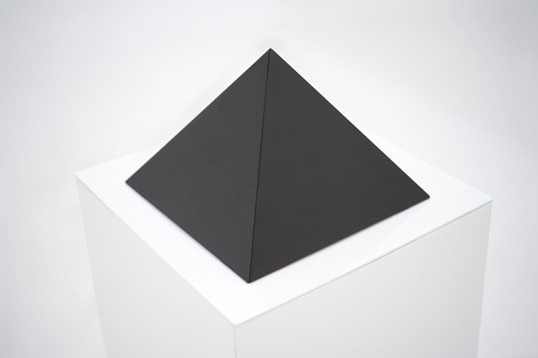
Quadratum Nigrum: Mateusz Okoński, Jakub Skoczek and Jakub Woynarowski, ‘Mundus Subterraneus’, 2012, photo courtesy the artists
Quadratum Nigrum (Mateusz Okoński, Jakub Skoczek, Jakub Woynarowski) | “Fiat Lux”
Duration: May 17th through June 14th, 2015
Curator: Anna Lebensztejn
Bunkier Sztuki Gallery of Contemporary Art










